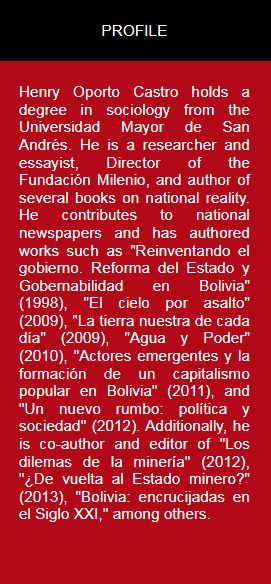Vesna Marinkovic U.
The statist and chaotic policies of the MAS government have driven away foreign investment, leaving the country without the capacity to replenish gas reserves and, consequently, to maintain a growth rate in production and exports…
1It is said that the hydrocarbon sector in Bolivia is in clear deterioration. What would be the causes of this decline?
The causes are evident: the nationalization of hydrocarbons in 2006 interrupted the cycle of investments and growth in export markets’ production. The statist and chaotic policies of the MAS government have driven away foreign investment, leaving the country without the capacity to replenish gas reserves and, consequently, to maintain a growth rate in production and exports. The improvised and corrupt management of YPFB (Bolivian state-owned oil company) has led to its failure.
2What are the most significant signs of this decline at the moment?
Gas production is in sharp decline. Since 2015, it has fallen by 35%, and the trend is expected to continue. The large gas fields have been depleted, and there is an increasing inability to meet the contracted volumes for sale to Brazil and Argentina. These countries are much less dependent on Bolivian gas. We have ceased to be self-sufficient in fuel production and now the country depends on imports. Bolivia, which once dreamed of being the energy center of South America, has become a net importer of hydrocarbons. By 2027, we might not have enough gas volumes for export, and by 2030, we might have to import natural gas for a domestic market that is growing at a rate of 3% per year.

3What should be done to reverse this situation?
A radical change in hydrocarbon policy is needed to open the sector to foreign investment, especially in the exploration of new fields, with clear rules, contract stability, reduced taxes to make investment attractive, seeking new markets, restructuring, and cleaning up YPFB. These are actions that, if done properly, will take several years to produce results, but the sooner we start, the more hardships the country will avoid. Regaining the confidence of investors, this is a crucial challenge. However, it is doubtful whether the government wants or if it is capable of making this turn.
4Until 2022, hydrocarbon exports from Bolivia showed a downward trend. Has this situation changed in any way?
The decline in oil&gas exports is structural, stemming from a contraction in productive capacity and a lack of reserves, on the one hand, and a loss of markets, on the other. Argentina has already said that it could suspend its purchases of Bolivian gas in 2024. If this happens, it will be a terrible blow to the Bolivian economy. Becoming a transit country for Argentine gas to Brazil is little consolation.
5Does the crisis in the hydrocarbon sector exacerbate the crisis in the national economy?
The boom we experienced between 2006 and 2015 was mainly sustained by gas exports and high prices when Bolivia had large reserves and production capacity thanks to investments in the 1990s and 2000s (before Evo’s arrival). Gas revenue contributed almost half of fiscal revenues, driving public spending and economic growth like never before. All this has changed significantly in recent years. The collapse of the hydrocarbon sector is one of the key factors in the current crisis. Note that between 2019 and 2022, the GDP of the oil sector had a negative growth of 12%. To make things worse, we now spend more on importing fuel than on exporting natural gas; the deficit in the energy trade balance amounted to 1.3 billion dollars last year.
6Being YPFB a public company, the most strategic and important until recently, would it be useful for it to stop being a burden for the State and, for example, pass into the hands of workers, as some analysts suggest in relation to other State-owned companies?
To save YPFB, a deep corporate restructuring is necessary, as well as reducing its excessive functions, which it fulfills poorly. The critical problem of YPFB is its politicization, its incompetent bureaucracy, clientelism, and patronage that dominate its administration. The company is held hostage by the union and other powerful groups that benefit from it. Who will bell the cat? It doesn’t seem that the government wants to do it, so the most likely outcome is that the disaster will continue until perhaps a solution arises from the wreckage.


The decline in oil&gas exports is structural, stemming from a contraction in productive capacity and a lack of reserves, on the one hand, and a loss of markets, on the other…”
7Should the fuel subsidy in Bolivia be lifted?
In 2022, the fuel subsidy was $1.7 billion, an immense amount for an economy with a fiscal crisis of over 7% of GDP for eight consecutive years. The fiscal situation is unsustainable. Reviewing the subsidy policy is common sense. Other countries have done it with success. Bolivia can learn from these experiences to target subsidies to the poor and vulnerable sectors. But this requires vision, political courage, leadership, and national responsibility. These conditions are nonexistent in Bolivia.

Recovering the confidence of investors is a crucial challenge. However, it is doubtful whether the government wants or if it is capable of making this turn.”
